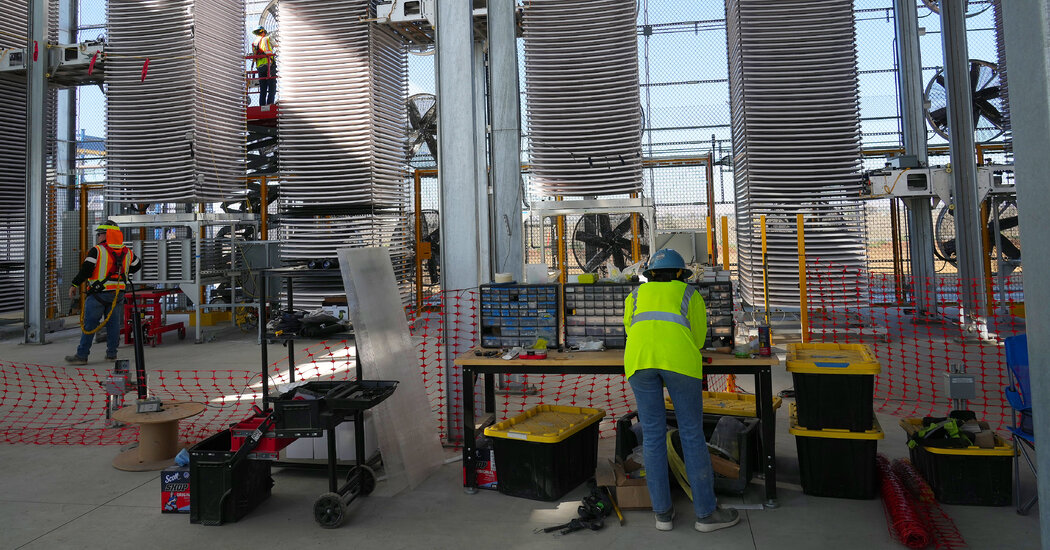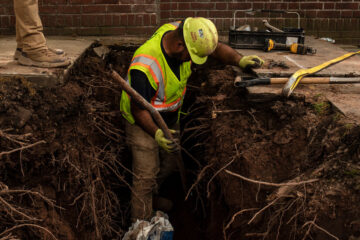[ad_1]
In an open-air warehouse in California’s Central Valley, 40-foot-tall racks hold hundreds of trays filled with a white powder that turns crusty as it absorbs carbon dioxide from the sky.
The start-up that built the facility, Heirloom Carbon Technologies, calls it the first commercial plant in the United States to use direct air capture, which involves vacuuming greenhouse gases from the atmosphere. Another plant is operating in Iceland, and some scientists say the technique could be crucial for fighting climate change.
Heirloom will take the carbon dioxide it pulls from the air and have the gas sealed permanently in concrete, where it can’t heat the planet. To earn revenue, the company is selling carbon removal credits to companies paying a premium to offset their own emissions. Microsoft has already signed a deal with Heirloom to remove 315,000 tons of carbon dioxide from the atmosphere.
The company’s first facility in Tracy, Calif., which opens Thursday, is fairly small. The plant can absorb a maximum of 1,000 tons of carbon dioxide per year, equal to the exhaust from about 200 cars. But Heirloom hopes to expand quickly.
“We want to get to millions of tons per year,” said Shashank Samala, the company’s chief executive. “That means copying and pasting this basic design over and over.”
The idea of using technology to suck carbon dioxide from the sky has gone from science fiction to big business. Hundreds of start-ups have emerged. The Biden administration in August awarded $1.2 billion to help several companies, including Heirloom, build larger direct air capture plants in Texas and Louisiana. Companies like Airbus and JPMorgan Chase are spending millions to buy carbon removal credits in order to fulfill corporate climate pledges.
Critics point out that many artificial methods of removing carbon dioxide from the air are wildly expensive, in the range of $600 per ton or higher, and some fear they could distract from efforts to reduce emissions. Environmentalists are wary of oil companies investing in the technology, fearing it could be used to prolong the use of fossil fuels.
Others say it’s essential to try. Nations have delayed cutting greenhouse gas emissions for so long, scientists say, that it is almost impossible to keep global warming at relatively tolerable levels unless countries both cut emissions sharply and also remove billions of tons of carbon dioxide from the atmosphere by midcentury, far more than can be achieved by simply planting trees.
“The science is clear: Cutting back carbon emissions through renewable energy alone won’t stop the damage from climate change,” Energy Secretary Jennifer Granholm, who planned to attend the opening of Heirloom’s facility, said. “Direct air capture technology is a game-changing tool that gives us a shot at removing the carbon pollution that has been building in the atmosphere since the Industrial Revolution.”
Carbon-absorbing rocks
Heirloom’s technology hinges on a simple bit of chemistry: Limestone, one of the most abundant rocks on the planet, forms when calcium oxide binds with carbon dioxide. In nature, that process takes years. Heirloom speeds it up.
At the California plant, workers heat limestone to 1,650 degrees Fahrenheit in a kiln powered by renewable electricity. Carbon dioxide is released from the limestone and pumped into a storage tank.
The leftover calcium oxide, which looks like flour, is then doused with water and spread onto large trays, which are carried by robots onto tower-high racks and exposed to open air. Over three days, the white powder absorbs carbon dioxide and turns into limestone again. Then it’s back to the kiln and the cycle repeats.
“That’s the beauty of this, it’s just rocks on trays,” Mr. Samala, who co-founded Heirloom in 2020, said. The hard part, he added, was years of tweaking variables like particle size, tray spacing and moisture to speed up absorption.
The carbon dioxide still needs to be dealt with. In California, Heirloom works with CarbonCure, a company that mixes the gas into cement, where it mineralizes and can no longer escape into the air. In future projects, Heirloom also plans to pump carbon dioxide into underground storage wells, burying it.
Heirloom won’t disclose its exact costs, but experts estimate that direct air capture currently costs around $600 to $1,000 per ton of carbon dioxide, making it by far the most expensive way to curb emissions, even after new federal tax credits worth up to $180 per ton.
Heirloom has set a long-term target of $100 per ton and aims to get there, in part, through economies of scale and mass-produced components. For its next plant, planned in Louisiana, Heirloom will use a more efficient kiln and a denser layout to save on land costs.
“We’ve seen this with solar panels, with gas turbines. As you deploy more, the costs come down,” said Julio Friedmann, chief scientist of Carbon Direct, a consulting firm. “There are lots of reasons to think it can happen here, too.”
Finding enough clean power for the energy-intensive process could be a challenge. In California, Heirloom paid a local provider to add more renewable electricity to the grid. But experts say care is needed to ensure that direct air capture plants don’t inadvertently cause emissions from the electricity sector to rise by diverting wind or solar power from elsewhere.
“If a company says it’s removing a ton of carbon dioxide, it’s important to make sure everything gets accounted for,” said Danny Cullenward, a research fellow with the Institute for Carbon Removal Law and Policy at American University. “That’s not always as easy as it sounds.”
Paying for carbon removal
Even if direct air capture remains expensive, some customers are willing to pay.
Microsoft, which is Heirloom’s biggest customer, has set a goal of going carbon negative by 2030. That means first doing everything it can to cut emissions, like powering data centers with renewable electricity. But the company also wants to offset emissions from activities that aren’t easy to clean up, like the production of the cement it uses, and plans to compensate for its historical emissions.
Microsoft won’t buy traditional offsets, such as paying people to protect forests, because they are difficult to verify and may not be permanent. Pulling carbon dioxide from the air and burying it seemed more durable and easier to measure.
“Carbon removal can be a lot more expensive than offsets, but what you’re paying for in terms of climate impact is radically different,” said Brian Marrs, Microsoft’s senior director of energy and carbon.
It’s too early to predict which carbon removal technologies will work best, Mr. Marrs said, so the company is investing in a variety of approaches besides Heirloom’s. That includes a different direct air capture project in Wyoming and a start-up claiming to remove atmospheric carbon by burying seaweed deep in the ocean.
“The more innovation we can see in this space, the better,” Mr. Marrs said.
To date, however, only a small number of wealthy companies have been willing to pay for engineered carbon removal.
In an attempt to build confidence in the market, the Energy Department in September announced it would buy $35 million worth of carbon removal credits from up to 10 providers, in order to establish new guidelines around what counts as a “high quality” project.
“Carbon removal is getting a lot attention, but there aren’t yet enough buyers out there to get to the scale we need,” said Noah Deich, deputy assistant secretary for the Energy Department’s Office of Carbon Management. “We’re trying to change that.”
Heirloom stands out in another way. In October, the company publicly pledged that it won’t accept investments from oil and gas companies or use its technology to enable fossil fuel production.
That appeared to be a response to one company in particular: Occidental Petroleum, an oil and gas giant that has emerged as a leading player in direct air capture. The company’s chief executive, Vicki Hollub, has said the technology could “preserve our industry,” a statement that alarmed environmentalists.
Occidental is building a different type of direct air capture plant in West Texas that can absorb 500,000 tons of carbon dioxide per year. The company then plans to inject some of the gas into depleted oil wells in order to extract more crude, a practice known as enhanced oil recovery. Occidental said that emissions from the new oil would be offset by the injected carbon dioxide that remained underground, creating a carbon-neutral fuel that could be used in airplanes or ships that are difficult to decarbonize.
“No matter what scenario you look at, the world is still going to be using millions of barrels of oil for years to come,” said Richard Jackson, Occidental’s president of United States onshore resources and carbon management. “So, isn’t it better if we’re using net-zero oil?”
Mr. Jackson added that Occidental’s vision for direct air capture was still evolving. The company will also bury much of the carbon dioxide it captures in underground saline aquifers, in order to sell carbon removal credits.
Still, Occidental’s oil proposal sparked a backlash. “There’s a big difference between exploring an infant technology to see if it can be developed, versus telling the public, ‘If we do this, we can continue burning fossil fuels forever,’” former Vice President Al Gore said at a recent New York Times event.
The debate over how big a role carbon removal should play in tackling climate change is still in early stages, said Emily Grubert, associate professor of sustainable energy policy at the University of Notre Dame. But with billions of dollars rushing in, she said, it’s a crucial discussion.
“Using direct air capture to offset large amounts of oil production is a completely different scale than using it to offset a few activities, like fertilizer use, where it’s impossible to cut emissions,” Dr. Grubert said. “And there’s a broad societal interest in figuring out what scale of carbon removal we’re committing to.”
[ad_2]
Source link




